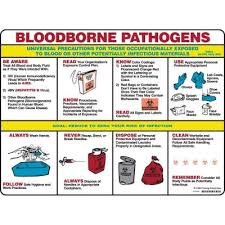According to OSHA Blood Borne Pathogens are “infectious
microorganisms in human blood that can cause disease in humans.” Some of these
blood borne pathogens include Hepatitis B, Hepatitis C, and HIV. Individuals from a variety of occupations can
be exposed to blood borne pathogens, they can be exposed through being stuck by
a needle or by being cut. If exposed to these blood borne pathogens it is
important to look into what can be done to control the exposure. It is imperative for employers to implement
an exposure control plan for protection measures of everyone working in the lab
specifically with blood. Plans must describe in detail the work practice
controls, where the personal protective clothing and equipment is located, and
specific training.
Our class was able to visit Dr. Michael Kushnick’s lab. Dr.
Kushnick is an exercise physiology professor at Ohio University who researches
cell biology, specifically dealing with blood.
Dr. Kushnick is constantly dealing with anonymous blood samples, meaning
that he and the students working in his lab are dealing with potentially
infectious blood, and have a higher risk of exposure to blood borne pathogens. Dr.
Kushnick is the only one using the lab for his research, and he has about 13
students working with him. Dr. Kushnick is in charge of enforcing the rules and
guidelines for the protection of everyone working in his lab.
Blood borne pathogens are very dangerous, and Dr. Kushnick
was fast at letting us know that information. He told us a story of an incident
that had happened to him. On a Sunday afternoon Dr. Kushnick went into his lab
to finishing up some work, he did not have the appropriate protective clothing
on. Kushnick had on shorts and open toe shoes. As he was taking a vial of a
blood sample out of the fridge it dropped and ended up cutting him. Dr.
Kushnick took the appropriate measures and followed the Chemical Hygiene Plan. He
called the necessary people and was sent to the emergency room. The sample that
he was exposed to was anonymous so he had no knowledge if the sample was
infected or not.
 There are a countless number of things that can go wrong
when working in a lab specifically with blood. The problems that can occur are
risks of exposure through open cuts being contaminated, and inhalation. The
experience that Dr. Kushnick shared was a clear example of being exposed through
cut contamination. Exposure through inhalation can happen, when a vile is opened
and the blood vapors are breathed in. When working with blood borne pathogens
it is essential to take the appropriate measures and precautions to keep
everyone in the lab safe. One of the most important things to have in order to
keep his lab safe is student training. They need to know the how to work with
blood and the risks that is associated when working in the lab.
There are a countless number of things that can go wrong
when working in a lab specifically with blood. The problems that can occur are
risks of exposure through open cuts being contaminated, and inhalation. The
experience that Dr. Kushnick shared was a clear example of being exposed through
cut contamination. Exposure through inhalation can happen, when a vile is opened
and the blood vapors are breathed in. When working with blood borne pathogens
it is essential to take the appropriate measures and precautions to keep
everyone in the lab safe. One of the most important things to have in order to
keep his lab safe is student training. They need to know the how to work with
blood and the risks that is associated when working in the lab.
I found many things to be interesting in the way that Dr.
Kushnick operated his lab. One specific thing that stood out to me was how poor
his labeling was specifically on the hazardous waste container. First, the
container that he was keeping his hazardous materials in was an old juice
container, and the signage on it was a faded skull and cross bone. This stood
out to me because at first glance it looked like juice and it was hard to
determine what it actually was without closely examining. The next piece of
information that Dr. Kushnick shared with our class is that he has personal
protective clothing available but does not enforce the individuals in his lab
to utilize the gear.
https://www.osha.gov/SLTC/etools/hospital/hazards/bbp/bbp.html
https://www.osha.gov/SLTC/bloodbornepathogens/bloodborne_quickref.html

No comments:
Post a Comment